Popular courses 'Calculus' at Calculus
Calculus Study guides, Class notes & Summaries
Looking for the best study guides, study notes and summaries about Calculus? On this page you'll find 152 study documents about Calculus.
All 152 results
Sort by
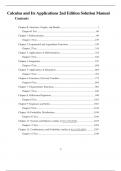
-
Complete Solution Manual Calculus and Its Applications 2nd Edition Questions & Answers with rationales
- Exam (elaborations) • 1361 pages • 2023
-
- $16.99
- 2x sold
- + learn more
Calculus and Its Applications 2nd Edition Solution Manual Complete Solution Manual Calculus and Its Applications 2nd Edition Questions & Answers with rationales PDF File All Pages All Chapters Grade A+
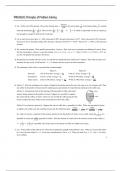 Popular
Popular
-
Solutions for Precalculus: Mathematics for Calculus, 8th Edition by Stewart
- Exam (elaborations) • 925 pages • 2023 Popular
-
- $39.49
- 2x sold
- + learn more
Complete Solutions Manual for Precalculus: Mathematics for Calculus, 8th Edition by Stewart. Full Chapters Solutions are included - Chapter 1 to 12 Prologue: Principles of Problem Solving. 1. FUNDAMENTALS. Chapter Overview. 1.1 Real Numbers. 1.2 Exponents and Radicals. 1.3 Algebraic Expressions. 1.4 Rational Expressions. 1.5 Equations. 1.6 Complex Numbers. 1.7 Modeling with Equations. 1.8 Inequalities. 1.9 The Coordinate Plane; Graphs of Equations; Circles. 1.10 Lines. 1.11 Solving Equation...
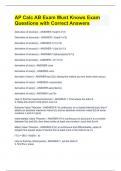
-
AP Calc AB Exam Must Knows Exam Questions with Correct Answers
- Exam (elaborations) • 2 pages • 2024
- Available in package deal
-
- $7.99
- + learn more
Derivative of arcsin(x) - ANSWER-1/sqrt(1-x^2) Derivative of arccos(x) - ANSWER--1/sqrt(1-x^2) derivative of arctan(x) - ANSWER-1/(1+x^2) derivative of arccsc(x) - ANSWER--1/(|x|√(x²-1)) derivative of arcsec(x) - ANSWER-1/(abs(x)sqrt(x^2-1)) derivative of arccot(x) - ANSWER--1/(1+x^2) derivative of sin(x) - ANSWER-cosx derivative of cos(x) - ANSWER--sinx derivatie of tan(x) - ANSWER-sec^2(x) (being this makes you two times more seccy) derivative of csc(x) - ANSWER--...
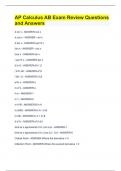
-
AP Calculus AB Exam Review Questions and Answers
- Exam (elaborations) • 2 pages • 2024
- Available in package deal
-
- $7.99
- + learn more
d sin x - ANSWER-cos x d cos x - ANSWER-- sin x d tan x - ANSWER-sec^2 x ∫sin x - ANSWER-- cos x ∫cos x - ANSWER-sin x ∫ sec^2 x - ANSWER-tan x d ln U - ANSWER-dU / U ∫ e^U dU - ANSWER-e^U ∫ dU / U - ANSWER-ln |U| e^ln x - ANSWER-x ln e^x - ANSWER-x ln e - ANSWER-1 ln 1 - ANSWER-0 ln A^B - ANSWER-B ln A ln (A/B) - ANSWER-ln A - ln B ln AB - ANSWER-ln A + ln B d e^U - ANSWER-e^U dU limit as x approaches 0 in: (sin x)/x - ANSWER-1 lim...
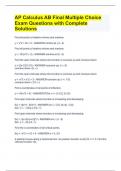
-
AP Calculus AB Final Multiple Choice Exam Questions with Complete Solutions
- Exam (elaborations) • 5 pages • 2024
- Available in package deal
-
- $7.99
- + learn more
Find all points of relative minima and maxima: y = x^2 + 6x + 5 - ANSWER-minima at (-3, -4) Find all points of relative minima and maxima: y = -12/(x^2 + 3) - ANSWER-minima at (0, -4) Find the open intervals where the function is concave up and concave down. y = (2x-12)^(1/3) - ANSWER-concave up: (-∞, 6) concave down: (6, ∞) Find the open intervals where the function is concave up and concave down. y = -x^3 + x^2 + 3 - ANSWER-concave up: (-∞, 1/3) concave down: (1/...
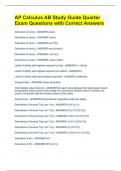
-
AP Calculus AB Study Guide Quarter Exam Questions with Correct Answers
- Exam (elaborations) • 2 pages • 2024
- Available in package deal
-
- $7.99
- + learn more
Derivative of sin(x) - ANSWER-cos(x) Derivative of cos(x) - ANSWER--sin(x) Derivative of tan(x) - ANSWER-sec^2(x) Derivative of sec(x) - ANSWER-sec(x) tan(x) Derivative of cot(x) - ANSWER--csc^2(x) Derivative of csc(x) - ANSWER--csc(x) cot(x) Limits of infinity with highest exponent on top - ANSWER--/+ infinity Limits of infinity with highest exponent on bottom - ANSWER-0 Limits of infinity with same highest exponent - ANSWER-coefficents Tangent lines - ANSWER-slope/ d...
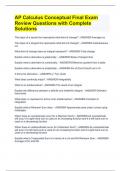
-
AP Calculus Conceptual Final Exam Review Questions with Complete Solutions
- Exam (elaborations) • 3 pages • 2024
- Available in package deal
-
- $9.49
- + learn more
The slope of a secant line represents what kind of change? - ANSWER-Average roc The slope of a tangent line represents what kind of change? - ANSWER-Instantaneous roc What kind of change does an integral represent? - ANSWER-Total change Explain what a derivative is graphically. - ANSWER-Slope of tangent line Explain what a derivative is numerically. - ANSWER-Difference quotient from a table Explain what a derivative is analytically. - ANSWER-lim of (f(x+h)-f(x))/h as h->0 3 ...
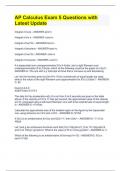
-
AP Calculus Exam 5 Questions with Latest Update
- Exam (elaborations) • 2 pages • 2024
- Available in package deal
-
- $7.99
- + learn more
Integral of cosx - ANSWER-sinx+c Integral of sin x - ANSWER--cosx+c Integral of sec^2x - ANSWER-tanx+c Integral of secxtanx - ANSWER-secx+c Integral of csc^2x - ANSWER--cotx+c Integral of cscxcotx - ANSWER--cscx+c If a trapezoidal sum overapproximates ∫0 to 4 f(x)dx, and a right Riemann sum underapproximates ∫0 to 4 f(x)dx, which of the following could be the graph of y=f(x)? - ANSWER-A- The one with a y intercept at three that is concave up and decreasing Let f be the f...
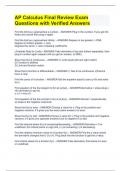
-
AP Calculus Final Review Exam Questions with Verified Answers
- Exam (elaborations) • 3 pages • 2024
- Available in package deal
-
- $9.49
- + learn more
Find the limit as x approaches a number. - ANSWER-Plug in the number. If you get 0/0, factor and cancel then plug in again. Find the limit as x approaches infinity. - ANSWER-Degree on top greater -> DNE Degree on bottom greater -> zero Degrees the same -> ratio of leading coefficients L'Hopitals Rule for Limits - ANSWER-Take derivative of top and bottom separately, then plug in number again (repeat until you get an answer, or DNE) Show that f(x) is continuous. - ANSWER-1) Li...
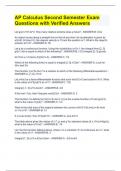
-
AP Calculus Second Semester Exam Questions with Verified Answers
- Exam (elaborations) • 4 pages • 2024
- Available in package deal
-
- $10.49
- + learn more
Let g(x)=x^4+4x^3. How many relative extrema does g have? - ANSWER-B. One An object moves along a straight line so that at any time t its acceleration is given by a(t)=6t. At time t=0, the objects velocity is 10 and the position is 7. What is the object's position at t=2? - ANSWER-D. 35 Let g be a continuous function. Using the substitution u=2x-1, the integral from [2, 3] g(2x-1)dx is equal to which of the following? - ANSWER-B. (1/2) integral [2, 3] g(u)du lim from x->3 (tan(x-3))...
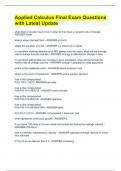
-
Applied Calculus Final Exam Questions with Latest Update
- Exam (elaborations) • 3 pages • 2024
- Available in package deal
-
- $9.49
- + learn more
what does a function have to be in order for it to have a constant rate of change - ANSWER-linear what is slope intercept form - ANSWER-y=mx+b whats the equation of a line - ANSWER-y-y initial=m(x-x initial) in a problem showing attendance at NFL games over the years, what will the average rate of change formula look like - ANSWER-change in attendance/ change in time in a problem talking about an increase in town population, what will the formula for relative rate of change look like...
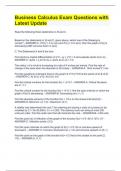
-
Business Calculus Exam Questions with Latest Update
- Exam (elaborations) • 4 pages • 2024
- Available in package deal
-
- $10.49
- + learn more
Read the following three statements A, B and C. Based on the statements A, B and C, given above, which one of the following is correct? - ANSWER-C. If f'(x) > 0 in (a,b) and f"(x) < 0 in (a,b), then the graph of f(x) is decreasing AND concave down in (a,b). C. The Statements A and B are true Find dy/dx by implicit differentiation of x^3 - xy + y^2 = 4 and evaluate dy/dx at (0,-2) - ANSWER-C. dy/dx = y-3x^2/ 2y-x; dy/dx at (0,-2) = 1/2 The radius r of a circle is increasing ...



